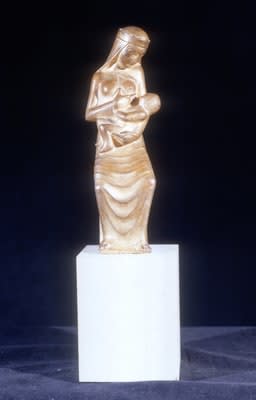
Eric Gill
To view all current artworks for sale visit philipmould.com
Eric Gill was arguably the greatest British artist-craftsman of the twentieth century. Along with friends such as Jacob Epstein, Gill was part of a new artistic generation that heralded the development of modern British sculpture. His life was marked by a tortuous religious and sexual exploration, culminating most notoriously in the incestuous relationships with his sisters. Gill’s most famous sculpture, ‘Prospero and Ariel’, was commissioned for Broadcasting House in London, while his name is now recognised and used by millions around the world everyday for the Gill fonts used in word processors.
This work is typical of the erotic religiosity that Gill employed to add a new and compelling dimension to the traditional subject of Madonna and Child. It was made on the eve of his conversion to Catholicism in March 1913, and is therefore not only an iconic part of Gill’s oeuvre, but a tangible remnant of perhaps the most important decision of his life. Gill began work on the plasticine original on 6th December 1912, and recorded that he spent ninety-six and a half hours completing it. This was craftsmanship on an epic scale.
Seven bronzes were cast, and this example, marked ‘3’, was first owned by a Mrs Barlow. That Gill recorded no.s 2 & 6 as being for sale at £10 10s 10d suggests that no. 3 was given as a gift, perhaps to a friend of the artist. Another version can now be found in the National Gallery, Johannesburg.
Provenance
First in the ownership of Mrs Barlow, 1913Literature
‘Eric Gill, The Sculpture. A Catalogue Raisonné’;Judith Collins, London, 1998, p. 79, no. 32
Be the first to hear about our available artworks
* denotes required fields
We will process the personal data you have supplied in accordance with our privacy policy (available on request). You can unsubscribe or change your preferences at any time by clicking the link in our emails.